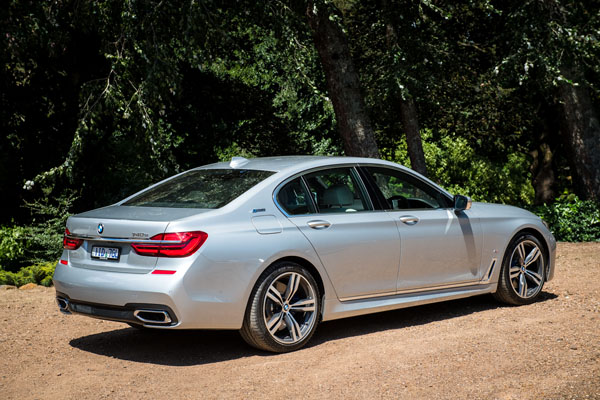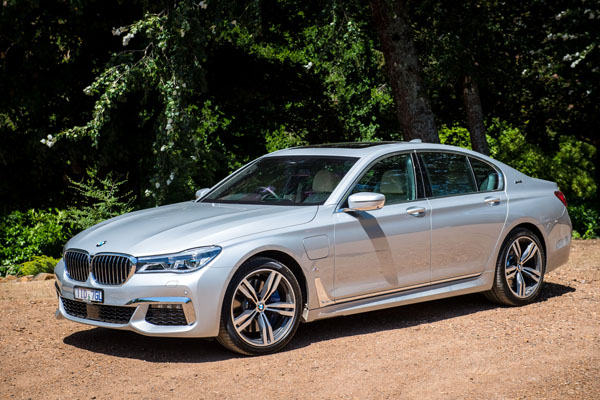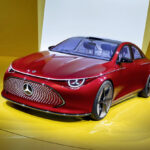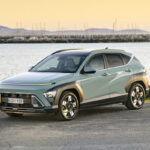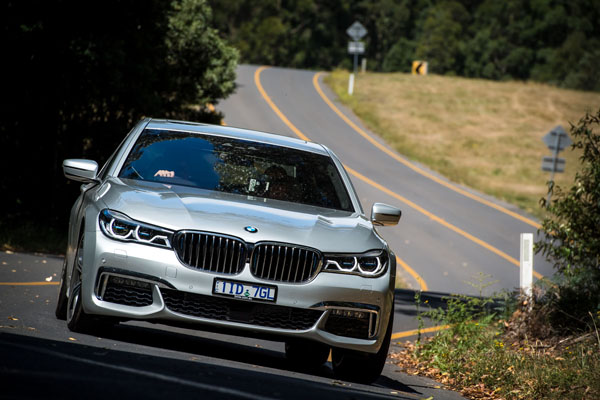
BMW has always been noted for its sporty models but for the past decade it has also been seriously researching and building full-electric, and petrol-electric hybrids. Electric vehicles like few others, because there’s a strong emphasis on sportiness melded into these emission reducing vehicles.
Indeed, BMW has set up an iPerformance division to develop and market these cars of the future.
We’ve just spent a fascinating week road testing a BMW 740e iPerformance. It has the same standard specification of the established 740i pure-petrol and is priced at $229,000 plus on-road costs.
STYLING
Hard to pick from the standard 7 Series at a distance, but the eDrive badges are a giveaway, as is the added ‘fuel’ flap on the left-front guard which gives access to the electric input.
High levels of standard equipment show this petrol-electric hybrid this is anything but a science experiment. It rides on 19-inch light-alloy wheels, has a glass sunroof and quality Nappa leather upholstery that is soft and comfortable. On the same subject there are heated seats for driver and front passenger, even heated armrests on the centre console and steering wheel. Wow, talk about being spoiled!
Infotainment is a 16-speaker Harman/Kardon surround sound system together with DAB+ digital radio.
Professional Navigation can be used by BMW Gesture Control, real time traffic information is excellent, as is the ability to get BMW Concierge Services set up all your plans.
POWERTRAIN
The letter ‘e’ in the sedan’s title obviously refers to electric, but the ’40’ in this 7 Series refers to the output you would anticipate from a conventional 4.0-litre engine. It actually has a 2.0-litre turbo-petrol four-cylinder engine producing 190 kW of power from 5000 to 6500 rpm and an impressive 400 Nm of torque, available all the way from 1550 to 4400 revs.
Working with the turbo-petrol is a liquid-cooled electric motor that’s integrated into the eight-speed automatic transmission. The motor is powered by a high-voltage battery beneath the rear seat. This lithium-ion unit is liquid-cooled and has a 9.2kWh capacity, with 7.4kWh usable.
The electric motor delivers 83 kW, and 250 Nm of torque and can provide emission-free motoring at speeds of up to 140 km/h without the petrol engine being used. (Don’t forget that the laws of automotive physics are different in Australia to other countries, where 140 km/h is normal on motorways.)
Mounted on the centre console, the eDrive button offers three modes: In the default Auto eDrive mode, it melds electric and petrol propulsion.
MAX eDrive mode biases the system to electric power, the petrol engine engaging either when the throttle is depressed beyond the kickdown detente or when the gearshift lever is pushed into sport mode.
Battery Control mode allows the 740e lets the petrol engine provide drive, as well as charging the battery pack, storing the charge for later electric driving.
With the supplied cable enabling connection to a standard 240-volt power supply, the BMW 740e iPerformance can be charged from an ordinary domestic household socket in around five hours.
Customers can option a BMW I Wallbox to be installed. This enables a charging rate of up to 3.7kW at 16 amps, and can provide a complete charge in 2.5 hours.
BMW also provides a ChargeNow service incorporating a card that grants simple, convenient access to partnered public charging stations.
SAFETY
BMW Driving Assistant Plus provides lane change and lane departure warning, steering and lane control assistant, forward collision warning and pedestrian warning with light city braking function, crossing-traffic warning (front and rear), rear collision prevention and active cruise control with stop and go function) rear view camera and surround view with 360 degree function and panorama view.
DRIVING
The 740e is big, imposing and ultra smooth to ride in. There is, of course, no noise from the electric motor. However, the little petrol unit made an unusual clicking sort of noise when accelerated hard. It wasn’t unpleasant, just different.
Like all electric vehicles the big 7 Series has the magical instantaneous throttle response that’s provided by an electric motor that has maximum torque from one rpm (yes, one rpm).
With the battery fully discharged after a lot of driving we called into a friend’s place for lunch and long catchup chats. We plugged the electric Bimmer into their 10-amp socket connected to their household solar system.
Three pleasant hours later the 740e estimated we had power for 21 kilometres, we actually managed 25 km, to get us all the way home with another one km still in the battery. Power from the sun took us all the way home at zero cost.
The next day we plugged into one of the EV charging stations at Pacific Fair shopping centre for an hour while we did some browsing and had a coffee. After that hour it had stored just 11 kilometres of travel. Less than we had hoped for.
Incidentally, we used the ChargeNow website to get details of charging stations in our area. There are currently only three in the sixth largest city in Australia. Hmm…
There are plenty of early adopters in our area, but if there’s little backup in the way of numerous charging stations they may decide not to take the electric route just yet.
Incidentally, when we asked the ChargeNow website for navigation information to the Pacific Fair using Google Maps it not only gave us driving instructions, but also provided the option of getting there by tram!
I guess trams are electric vehicles, but someone has to have a look at the website to sort this out.
When running on petrol, which frankly was most of the time, the big, heavy BMW 740e typically used seven to eight litres per hundred kilometres on motorways and 10 to 12 litres around town.
SUMMING UP
The long-awaited ‘better battery’ is still required if electric cars are to really make their name on the sales front. BMW has been one of the major leaders in technology for many decades and you can be sure the behind-the-scenes guys and gals are doing everything they can.
In the meantime the BMW 740e proves that you can have smooth, luxurious personal transportation in near silent running.
AT A GLANCE
MODEL RANGE
BMW 740e iPerformance 2.0-litre turbo-petrol / electric hybrid four-door sedan: (automatic): $229,000
Note: This price does not include government or dealer delivery charges. Contact your local BMW dealer for drive-away pricing.
SPECIFICATIONS (BMW 740e iPerformance 2.0-litre turbo-petrol / electric hybrid four-door sedan)
ENGINE:
Capacity: 1.998 litres
Configuration: Four cylinders in line
Maximum Power: 190 kW @ 6500 rpm
Maximum Torque: 400 Nm @ 1500 rpm
Fuel Type: Premium unleaded
Combined Fuel Cycle (ADR 81/02): 2.2 L/100km
CO2 Emissions: 50 g/km
DRIVELINE: Eight-speed automatic
DIMENSIONS, WEIGHT AND CAPACITIES:
Length: 5098 mm
Wheelbase: 3070 mm
Width: 1902 mm
Height: 1467 mm
Turning Circle: 12.3 metres
Kerb Mass: 1873 kg
Fuel Tank Capacity: 78 litres
BRAKES:
Front: Ventilated Disc
Rear: Ventilated Disc
STANDARD WARRANTY:
Three years / unlimited km




